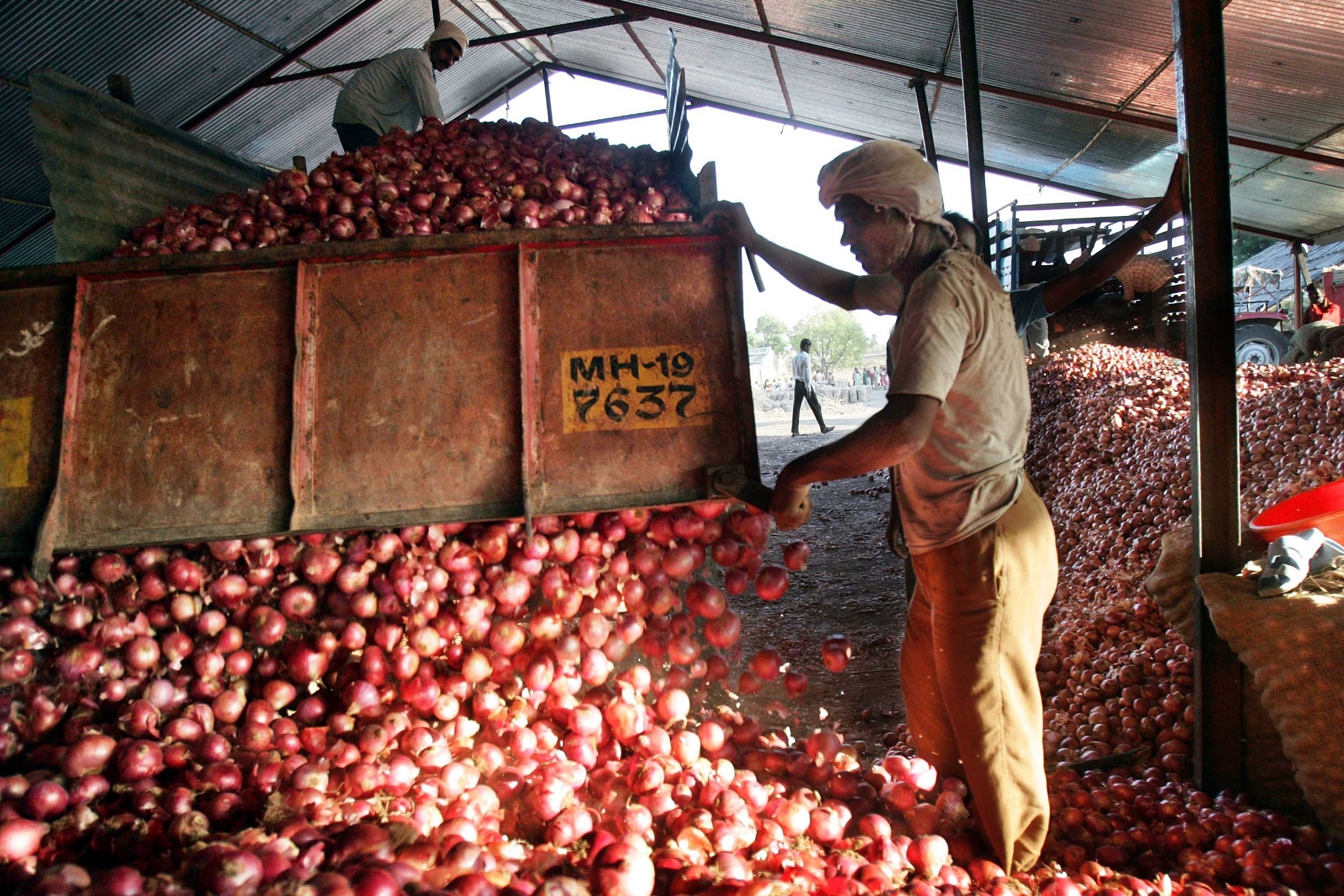Politics
Data Story: The Factors That Caused The Sharp Rise In Onion Prices, Explained
- The imports are expected to arrive between the middle of this month and early January.

Onions being off-loaded from a truck in Nashik (Representative Image) (Vikas Khot/Hindustan Times via Getty Images)
With onion prices surging since October this year, the Centre has decided to resort to importing the vegetable. On 9 November, it decided to import 1.20 (lt) onion to tame the prices.
Parastatal agency MMTC was asked to contract the imports. Unfortunately, nothing much has been heard, though around 6,100 tonnes were contracted for imports from Egypt. On Monday (2 December), MMTC was asked to buy another 11,000 tonnes from Turkey.
The imports are expected to arrive between the middle of this month and early January.
Despite various measures, including decisions to import and ban export, the Centre has been finding it tough to control surging onion prices that are ruling over Rs 100 at many retail outlets in the country.
At the Agricultural Produce Marketing Committee (APMC) yard in Nashik, the modal price or the rate at which most of the onions were sold on 2 December (Monday) was Rs 6,501 a quintal.
Such a rate in the primary agricultural market results in prices nearly doubling at retail outlets.
Data on Agmarket website, which provides prices of various agricultural products across the country, show that onion prices, after moderating to below Rs 5,000 a quintal during 28-30 November, have spiked again in the first two days of this month.
Data also shows that onion arrival during the week-ending 2 December was 644 tonnes, about a fifth of the 3,103 tonnes that arrived during the same period last year.
The spike in onion prices has resulted in the Narendra Modi government being criticised for its failure to control the surge. Memes on social media show onion as something precious as gold.
While there is no gainsaying that prices are likely to rule at these levels for a few more weeks, it would be worthwhile to look into the reasons for the spike.
In India, early Kharif onions are harvested during October-December after the crop is transplanted during July-August. The late Kharif crop is harvested during January-March after October-November transplantation, while Rabi onions hit the market during March-end-May after crop transplant during December-January.
Thus, there is a huge gap in arrivals between May and October due to which prices tend to rise. Supplies during this period are met through onions that are stored by farmers and traders.
The fact that Rabi onion has a larger shelf life than Kharif onion also helps to a large extent in maintaining supplies.
According to the Department of Horticulture, heavy rains during September-October damaged the onion crop that was ready for harvest.
In Madhya Pradesh, 58 per cent of the crop ready for harvest was damaged, while in Karnataka, from where Kharif onion arrivals begin, 18 per cent of the crop was damaged. Andhra Pradesh reported a two per cent damage of its crop.
The Maharashtra crop that was ready for harvest in October was affected badly due to rains under the influence of Cyclone Maha. A major portion of the crop in the State, the top onion producer in the country, was damaged in the unseasonal rains.
According to the Indian Council of Agricultural Research and Directorate of Onion and Garlic Research, the entire crop in Maharashtra was affected by the rains. The late Kharif crop is also feared to have been affected by October rains.
In regions such as Baramati and Purandar, 80 per cent of the crop has been damaged. Diseases have affected 60 per cent of the onion crop, while 50 per cent of onion nurseries have been affected by the rains, raising fears even over the Rabi crop.
In these circumstances, it is unfair to criticise the Centre. If prices do not increase when supplies are low, then there is something wrong with the country's economy and market.
Swarajya took a look at the arrivals during October-November for a period of 10 years.
Data sourced from Nashik-based National Horticultural Research and Development Foundation show that arrivals at 4.39 lakh tonnes (lt) in October this year were the second-lowest in a decade. In 2011, the arrivals were the lowest at 4.23 lt.
Arrivals in November were the lowest in 11 years at 3.88 lt. In 2008, November arrivals were 3.45 lt.
The important aspect here is that since 2015, total supplies during October-November have always been over 10 lt — they topped 15 lt in 2016. Compared to last year, supplies are over 41 per cent lower this year, thus leading to a sharp spike in prices.
Thus, it is clear that prices have surged since market forces — demand and supply — are at play than any extraneous reasons as in December 2010-January 2011.
Then, onion traders and a few big traders with well-connected networks played a huge role in hoarding onion and driving its prices up.
This year, with supply-demand coming into play in the market, there is no doubt that consumers will have to pay more for their onions, probably even beyond the New Year.
Introducing ElectionsHQ + 50 Ground Reports Project
The 2024 elections might seem easy to guess, but there are some important questions that shouldn't be missed.
Do freebies still sway voters? Do people prioritise infrastructure when voting? How will Punjab vote?
The answers to these questions provide great insights into where we, as a country, are headed in the years to come.
Swarajya is starting a project with an aim to do 50 solid ground stories and a smart commentary service on WhatsApp, a one-of-a-kind. We'd love your support during this election season.
Click below to contribute.
Latest